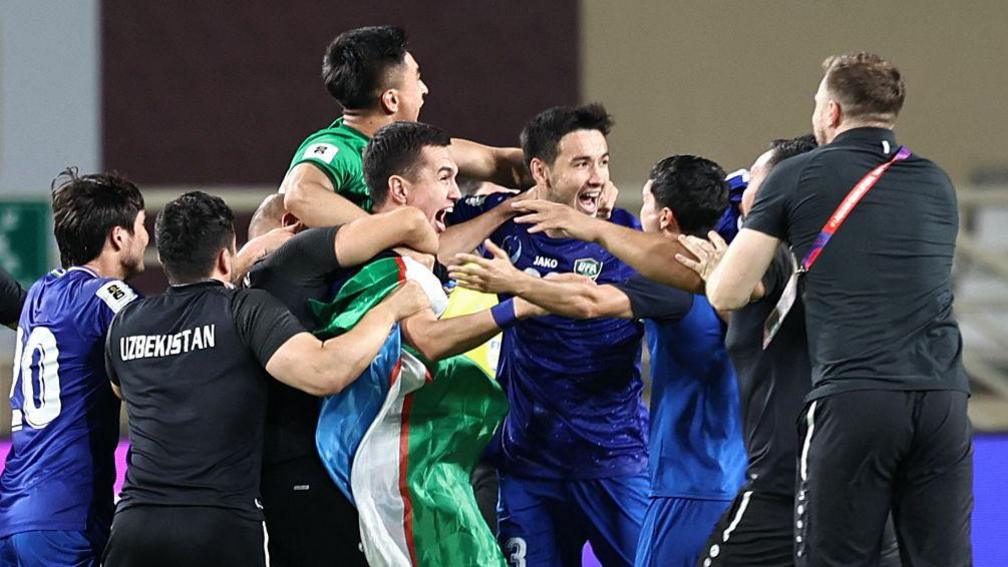
Uzbekistan have qualified for the World Cup for the first time
Andy Cryer
BBC Sport Senior Journalist
Emlyn Begley
BBC Sport journalist
Uzbekistan and Jordan have qualified for their first World Cups, while South Korea have also secured their place at the tournament.
They become the eighth, ninth and 10th teams to confirm their spots at the expanded 48-team tournament in United States, Canada and Mexico in 2026.
The three hosts have qualified automatically, while the latest trio to qualify join Japan, New Zealand, Iran and Argentina.
Uzbekistan drew 0-0 with the United Arab Emirates while South Korea beat Iraq 2-0 later in the day to qualify for their 11th straight World Cup, a result that meant Jordan’s 3-0 win against Oman confirmed their historic qualification.
Ranked 57th in the world and, with a population of 36 million, Uzbekistan played their first match as a sovereign nation in June 1992 after leaving the Soviet Union, and were accepted by world governing body Fifa two years later.
The closest Uzbekistan came previously to qualifying was during a controversial campaign in 2006, when they were in a two-legged playoff against Bahrain to determine who would be the Asian Football Confederation’s representative to face Concacaf’s Trinidad and Tobago. The winner of that match would then qualify for the finals in Germany.
Uzbekistan won the first leg 1-0, but a refereeing error led to Fifa ordering the match be played again, and they ultimately lost out on away goals.
The Uzbeks, however, have qualified for every Asian Cup finals since 1996 and progressed to the knockout phase in each appearance since 2004, including a run to the semi-finals in 2011 and the quarter-finals last year.
Asian Cup runners up Jordan are ranked 62nd in the world and are competing in their seventh World Cup qualifiers, since their first in 1986.
The closest they have previously come to qualifying was losing an intercontinental play-off to Uruguay in 2014.
So how does World Cup qualifying work?
South America
Qualifying places: Six, plus one into intercontinental play-offs
Teams already through: Argentina
South American qualifying comprises a big group involving all 10 teams – and started in September 2023.
The top six all reach the World Cup, with seventh place going into the intercontinental play-offs.
With four out of 18 games left, Argentina – who have already qualified – Ecuador, Uruguay, Brazil, Paraguay and Colombia occupy the top six – with Venezuela seventh.
Asia
Qualifying places: Eight, plus one into intercontinental play-offs
Teams already through: Japan, Iran, Uzbekistan, South Korea, Jordan
Asian qualifying started in October 2023 with the lower-ranked teams in action.
We are now in the third round, where the top two teams in three different groups qualify automatically.
Japan, Iran, Uzbekistan, South Korea and Jordan have now already sealed their slots, while Australia currently occupy the last automatic qualification spot.
The teams who finish third and fourth in each six-team group go on to a fourth round where they have another chance to qualify. There is even a fifth round.
Africa
Qualifying places: Nine, plus one into intercontinental play-offs
Teams already through: None
There are nine African groups of World Cup qualifying, each with six teams, which started in November 2023.
The top team in each group go through automatically. With four games to go, the current leaders are Egypt, DR Congo, South Africa, Cape Verde, Morocco, Ivory Coast, Algeria, Tunisia and Ghana.
The best four runners-up go into play-offs… for the chance to compete in the intercontinental play-offs.
North, Central American and Caribbean
Qualifying places: Six (including three hosts), plus two into intercontinental play-offs
Teams already through: None through qualifying – USA, Canada and Mexico automatically as co-hosts
The Concacaf qualifying takes a different look, with three of their biggest hitters not involved as they have qualified as hosts – but still plenty of spots up for grabs.
Like Europe, there is still a long way to go with qualifying not possible until the autumn.
There are six five-team groups, with the top two from each advancing to the next stage.
The third round then has three groups of four teams – with the winners of each group going to the World Cup and the two best-ranked runners-up going into the intercontinental play-offs.
Europe
Qualifying places: 16
Teams already through: None
There are 12 groups – with the winners of each group qualifying for the World Cup and the 12 runners-up going into play-offs with the four best-ranked Uefa Nations League group winners that have not already qualified – for four extra places.
Europe is the only continent that does not have a team in the intercontinental play-offs.
Qualifying only started in March – with some teams not even playing their first qualifiers until September while the Nations League continues.
The groups end in November, with the play-offs in March 2026.
Oceania
Qualifying places: One, plus one into intercontinental play-offs
Teams already through: New Zealand
Oceania qualifying has already ended – with New Zealand beating New Caledonia 3-0 in the final.
New Zealand go through to the World Cup automatically, as a result of the expanded World Cup. Oceania usually only gets a play-off spot.
New Caledonia, a French overseas territory, will take place in intercontinental play-offs in March 2026 – featuring teams from Africa, Asia, South America and North America – with two out of six teams going through.







